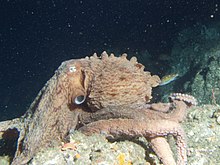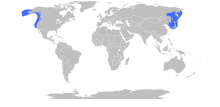Enteroctopus dofleini
| Giant Pacific octopus | |
|---|---|
 |
|
| E. dofleini observed off Point Piños, California, at a depth of 65 m (213 ft) | |
| Scientific classification | |
| Kingdom: | Animalia |
| Phylum: | Mollusca |
| Class: | Cephalopoda |
| Order: | Octopoda |
| Family: | Octopodidae |
| Genus: | Enteroctopus |
| Species: | E. dofleini |
| Binomial name | |
|
Enteroctopus dofleini (Wülker, 1910) |
|
 |
|
| Distribution of E. dofleini | |
| Synonyms | |
|
|
Enteroctopus dofleini, also known as the Giant Pacific octopus or North Pacific giant octopus, is a large marine cephalopod belonging to the genus Enteroctopus. Its spatial distribution includes the coastal North Pacific, along California, Oregon, Washington, British Columbia, Alaska, Russia, northern Japan, and Korea. It can be found from the intertidal zone down to 2,000 m (6,600 ft), and is best adapted to cold, oxygen-rich water. It is arguably the largest octopus species, based on a scientific record of a 71-kg (156-lb) individual weighed live. The alternative contender is the seven-arm octopus (Haliphron atlanticus) based on a 61-kg (134-lb) carcass estimated to have a live mass of 75 kg (165 lb). However, a number of questionable size records would suggest E. dofleini is the largest of all octopus species by a considerable margin.
All cephalopods have bilateral symmetry, a shell gland, a mantle, and well-developed head with sucker covered arms. The octopus has eight arms, each of which has two rows of suckers. Many of the suckers are lined with papillae or hooks for adhesion.
The web between the arms can be expanded to form a parachute-like structure to capture prey In the center of the arms is a mouth, containing beak and radula (toothed-tongue).
Cephalopods have a paralytic and digestive toxin in two salivary glands to aid in opening prey. Water is pulled into the mantle and over gills or lamellae for oxygen uptake, and can be ejected forcefully through the siphon for jet propulsion. They are able to reach speeds of up to 40 km/h (25 mph), but only for short sprints. They tend to use their arms as legs, and slowly crawl along the bottom. The siphon is also used to expel ink for escaping predators. The entire body of the octopus is compressible, so that they are able to fit through any opening slightly bigger than the size of their beak (the only hard part of their body). Their arms are muscular hydrostats, which lengthen, contract and contort. Octopuses are poikilothermic or cool-blooded, have three hearts and blue copper-based blood.
...
Wikipedia
